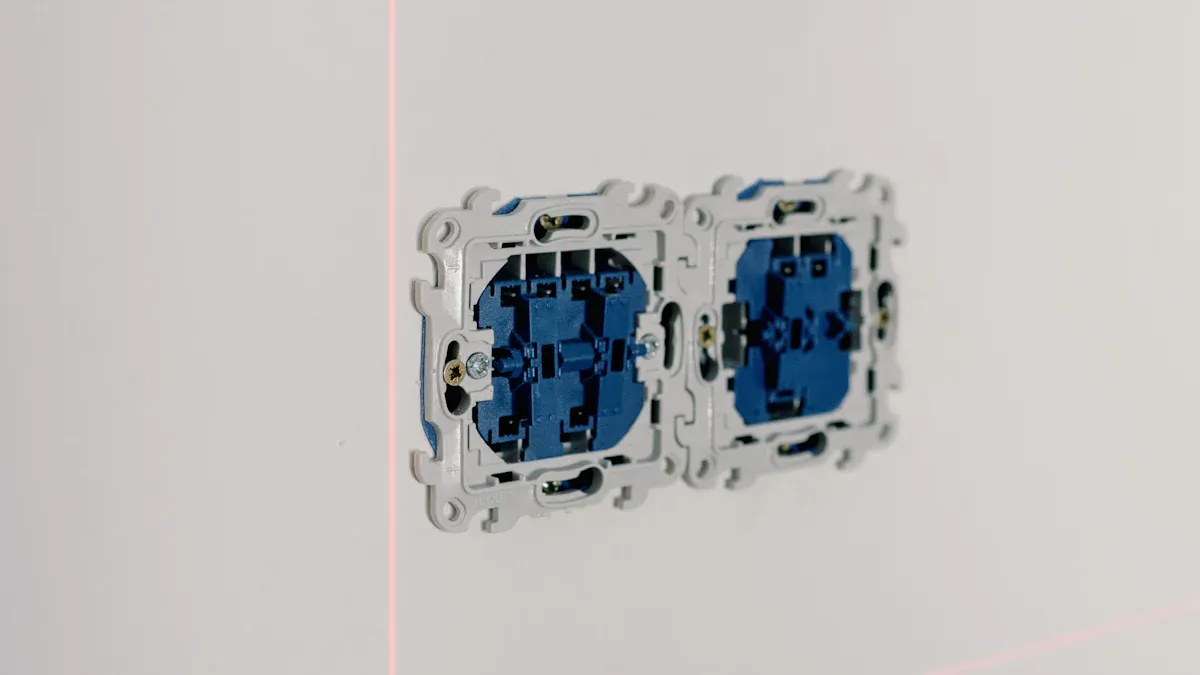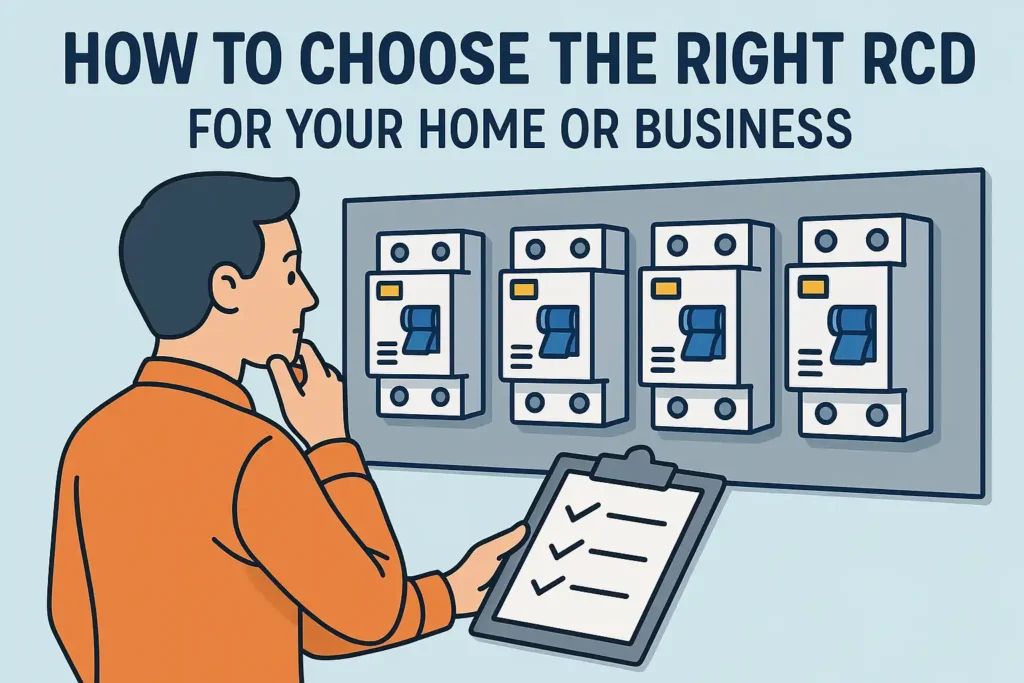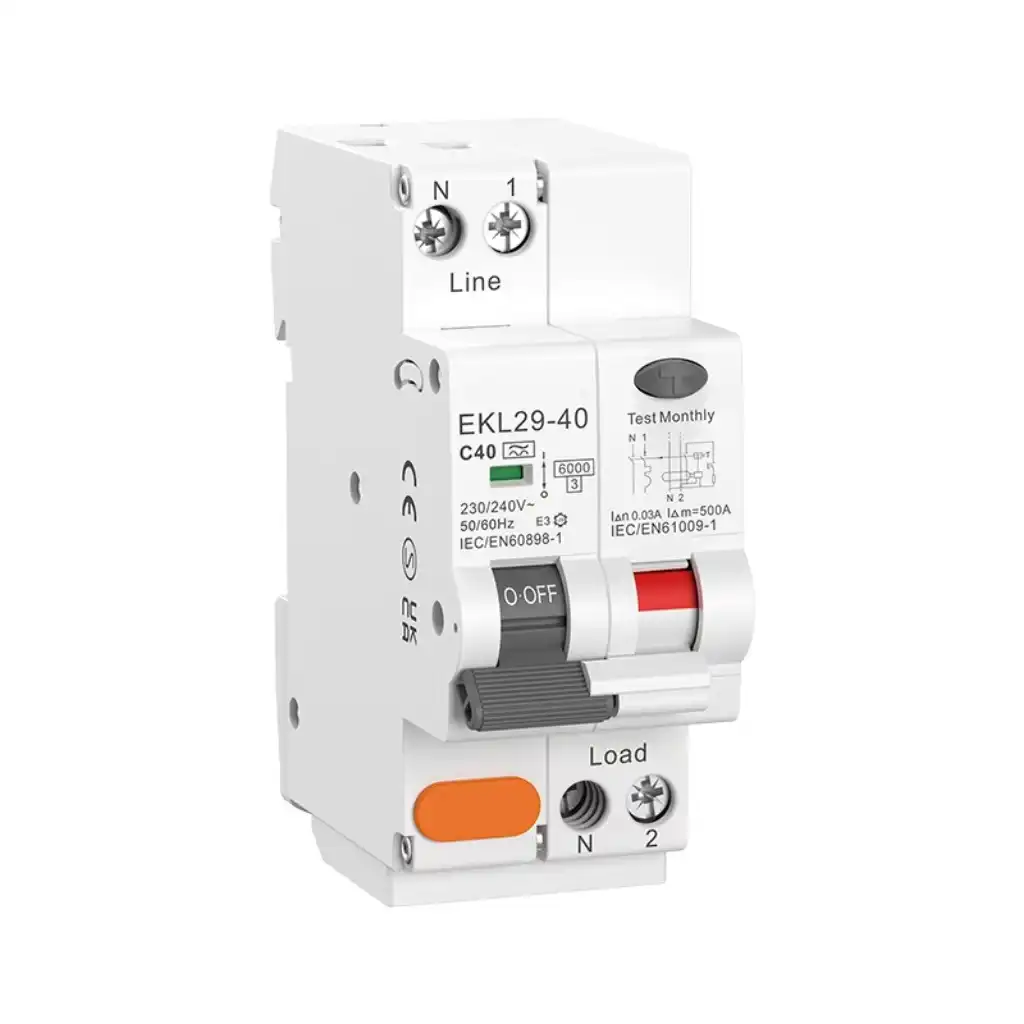To pick the right RCD, match its type, sensitivity, and rating to what you need and where you will use it. An RCD is a safety tool that turns off electricity fast if there is a problem. Choosing the right one helps stop electric shock and keeps your place safe. You should know if you want to put it at home, at work, or in special spots like outside or in wet rooms. If you are not sure or if it seems hard, ask a licensed electrician for help.
Key Takeaways
- Pick an RCD type that works with your equipment and where you live. This helps keep your home or business safe. Use 30mA sensitivity RCDs to protect people from shocks. Use higher ratings like 100mA or 300mA for fire safety in big places or businesses. Always make sure the RCD voltage, current rating, and frequency match your electrical system before you buy or put it in. Follow local electrical rules and have a licensed electrician put in and test your RCD. This makes sure you stay safe. Test your RCD every three months with the test button. This helps you know it works and keeps you safe from electric shock.
Application
You should know where you want to use the RCD. The place you put it changes what kind you need. You might need one at home, at work, or in special places like outside or in wet rooms. Each place has its own safety rules.
Home
People use RCDs at home to stop electric shock. New homes often have fixed RCDs because the law says so. These protect outlets, lights, and appliances all the time. Portable RCDs are good for short jobs or DIY work. Use them for extra safety, like when you use power tools outside. At home, you usually see Type AC and Type A RCDs. Type AC is for normal things like outlets and lights. Type A is better for things like washing machines or cooktops. Experts say to use both types for the best safety. You should also put lights and sockets on different RCDs. If one stops, the other still works.
Tip: Fixed RCDs are best for home wiring. Portable RCDs help with special jobs.
Business
Businesses have more wires and machines. You need to keep people and equipment safe. Many businesses use RCDs that can handle more power. These help stop fires and protect big machines. Type A and Type B RCDs are used a lot in businesses. Type B is needed for solar panels or electric car chargers. It can find more kinds of problems. RCBOs are also used in businesses. They give RCD protection and also stop overloads and short circuits. This lets you protect each wire without turning off everything. Businesses often use 100mA or 300mA RCDs to stop fires, not just shocks.
| RCD Type | Application Examples | Sensitivity/Features | Installation Notes |
|---|---|---|---|
| Type AC | Outlets, lighting | Finds AC currents | Use for normal loads |
| Type A | Appliances, EV charging | Finds AC and some DC | Use with electronics |
| Type B | Solar, EV charging | Finds AC, DC, smooth DC | Needed for renewables |
| Type F | Heat pumps, drives | Finds high-frequency currents | Use for special equipment |
Special Areas
Some places need more care. Wet rooms, outside, and workshops are more risky. You should use RCDs that are more sensitive, like 10mA or 30mA, in these places. These RCDs turn off faster and protect better from shocks. For pools, nurseries, or medical rooms, always pick the most sensitive RCDs. In workshops or farms, you might need 300mA RCDs for big machines and to stop fires.
Note: Always pick the right RCD type and sensitivity for the place. Wet and outside areas need more sensitive RCDs than dry rooms.
RCD Type
Picking the right RCD type keeps you safe. Each type works best with certain things and places. You should know what each type does before you choose.
AC Type
AC type RCDs only find problems with normal AC. Use these for simple circuits with no electronics. They work well with ovens, water heaters, or lights. AC type RCDs do not find DC faults. If you only have basic loads, this type is usually fine.
| RCD Type | Suitable For | Key Characteristics | Environmental/Equipment Considerations |
|---|---|---|---|
| Type AC | Circuits with no residual DC fault current | Detects AC sinusoidal residual current only; instantaneous operation | Suitable for resistive, capacitive, or inductive loads without electronics (e.g., showers, ovens) |
Note: AC type RCDs cost less but do not protect against faults from new electronics.
A Type
A type RCDs can find both AC and some DC faults. Many home devices now use electronics that make DC. Pick A type if you have things like washing machines or LED lights. These RCDs protect better than AC types with these devices.
| RCD Type | Residual Current Waveform Detected | Typical Load/Application | DC Component Tolerance |
|---|---|---|---|
| Type A | Sinusoidal and pulsating DC residual currents | Loads with single-phase rectifiers (e.g., heating plates) | Up to 6 mA smooth DC |
Tip: Use A type RCDs for circuits with appliances that have electronic parts or motors.
F and B Types
F and B type RCDs give more protection for special equipment. F type RCDs work with things like heat pumps or dishwashers. They can find mixed currents and some DC faults up to 10 mA. F type RCDs have a short delay, so they may not catch fast DC faults. They work well for slow DC faults.
B type RCDs give the most protection. You need these for solar panels, EV chargers, or big machines. B type RCDs can find AC, pulsating DC, and smooth DC. They cost more and need extra power, but they protect against more problems.
- B type RCDs are best for:
- PV systems
- EV charging stations
- Medical equipment with high DC
- Three-phase motors with speed drives
- F type RCDs are best for:
- Heat pumps
- Air conditioners
- Washing machines with speed motors
Note: Pick B type RCDs if your system has lots of DC. F type RCDs are good for less or slow DC.
S Type
S type RCDs are also called “selective” or “time-delayed” RCDs. These are used for main circuits. They have a built-in delay. Use S type RCDs to stop unwanted tripping when you have many RCDs. Put S type RCDs at the main switchboard. This way, only the bad circuit turns off, not everything.
- Use S type RCDs for:
- Main boards
- Systems with many RCDs
- Fire protection in big buildings
Tip: S type RCDs help keep power on in other places if one circuit has a problem.
How to Choose the Right Type
Match the RCD type to your equipment and place. Think about what devices you use and if they make DC. Check if you have solar panels, EV chargers, or speed drives. Use the table below to help you pick:
| RCD Type | Best For | Detects | Use When… |
|---|---|---|---|
| AC | Standard loads | AC only | No electronics or DC present |
| A | Modern appliances | AC + pulsating DC | Appliances with electronic parts |
| F | Speed drives | AC + mixed + some DC | Heat pumps, washers, air conditioners |
| B | PV, EV, industry | AC + all DC | Solar, EV charging, high DC |
| S | Main circuits | Time-delayed | Many RCDs, fire protection |
Always check the maker’s instructions and local rules before you choose. Picking the right RCD type keeps your system safe and saves money.
RCD Sensitivity
Picking the right sensitivity for your RCD is very important. Sensitivity uses milliamps (mA) as its unit. This number shows how much current leaking to earth will make the RCD turn off the power. A lower number means the RCD reacts to smaller leaks. This gives you better protection from electric shock. Higher numbers are used to stop fires, but they do not protect people as well.
30mA
A 30mA RCD turns off if it finds a leak of 30 milliamps or more. This is the normal level for keeping people safe from electric shock. Touching a live wire can be very dangerous, even at 30mA. The 30mA RCD is sensitive enough to catch these dangerous leaks fast. It does not trip for tiny, harmless leaks. Use 30mA RCDs for outlets, bathrooms, kitchens, and outside circuits. Most rules say you must use this level where people might touch wires.
Tip: Always pick 30mA RCDs for homes and places with high shock risk.
100mA
A 100mA RCD trips at a bigger leak. It does not protect people from shock as well as a 30mA RCD. You use 100mA RCDs mostly to help stop fires. These are common in businesses or big buildings. They protect the wiring but not people touching wires. You might see 100mA RCDs on main panels or on circuits with lots of machines.
- Use 100mA RCDs for:
- Fire safety in business buildings
- Circuits with many machines or long wires
- Main panels where 30mA would trip too much
300mA
A 300mA RCD is even less sensitive. It only trips when it finds a very big leak. This type is for fire safety in big places, farms, or workshops. It will not keep people safe from electric shock. Use 300mA RCDs for main circuits or where you want to stop fires but do not need to protect people.
Note: Never use 100mA or 300mA RCDs alone in places where people might touch wires. Always use them with 30mA RCDs for full safety.
How to Choose the Right Sensitivity
- Use 30mA for personal safety in homes, wet rooms, and outside.
- Use 100mA or 300mA for fire safety in big or business places.
- Do not use very sensitive RCDs (like 10mA) unless you really need them. They might trip too much.
- If you have many RCDs, plan their sensitivity to stop false trips. Put higher-rated RCDs first and 30mA ones after.
Remember: The right sensitivity keeps you safe from shocks and lowers fire risk. Always follow local rules and ask an expert if you are not sure.
Compatibility
When you choose an RCD, you must make sure it matches your electrical system. If you pick the wrong one, it may not work right or keep you safe. Always check the voltage, current rating, and frequency before you buy or install an RCD.
Voltage
You need to match the RCD voltage rating to your system. Most homes use 120V or 240V. Some businesses use higher voltages. If you use an RCD with the wrong voltage, it may not trip when needed. Always look at the label on your panel or ask your electrician if you are not sure.
Tip: Never use an RCD rated for a lower voltage than your system. This can cause the device to fail.
Current Rating
The current rating tells you how much current the RCD can handle. You must pick an RCD that matches or is higher than the main breaker or the load on the circuit. For example, if your circuit uses 32 amps, choose an RCD rated for at least 32 amps. If you use a lower-rated RCD, it can overheat or trip too soon.
Studies show that RCDs work best when their current rating matches the needs of your installation. Experts from the IET and laboratory tests confirm that matching the RCD type and rating to your equipment helps the device trip at the right time. This keeps your system safe and reliable, especially when you have equipment that can create DC currents, like solar panels or EV chargers.
| Circuit Load (Amps) | Minimum RCD Rating (Amps) |
|---|---|
| 16 | 16 |
| 32 | 32 |
| 40 | 40 |
Frequency
Most homes and businesses use 50 Hz or 60 Hz power. You must check that your RCD matches the frequency of your system. If you use the wrong frequency, the RCD may not sense faults correctly. Always check the product label or manual for the frequency rating.
- 50 Hz: Common in many countries
- 60 Hz: Standard in the United States
Note: Some special equipment may use different frequencies. Always check before you install.
When you match the voltage, current, and frequency, you help your RCD work as designed. This step keeps your home or business safe and helps you meet local codes.
Compliance & Safety

Local Codes
You must always follow your local electrical codes when you install safety devices. Each country or region has its own rules for RCDs. These rules tell you where to put them, what type to use, and how sensitive they must be. For example, in Germany, you need RCDs in bathrooms and on socket circuits. In France, you must use special RCDs for wet areas. In the United States, you use GFCIs, which work like RCDs, for outlets near water. These codes help keep you and your property safe.
| Country/Region | Main RCD Requirement |
|---|---|
| Germany | RCDs in bathrooms and sockets since 1984 |
| France | 30 mA RCDs for wet areas |
| United States | GFCIs for outlets near water |
| Australia | RCDs on power and lighting circuits |
Tip: Always check your local rules before you buy or install any safety device.
Installation
You should let a licensed electrician install your RCD. A professional knows how to connect the device the right way. They will check your wiring and make sure the RCD matches your system. International standards, like IEC 60364-6, guide electricians on how to test and install these devices. The electrician will test the RCD before turning on the power. This step helps prevent mistakes and keeps your home or business safe.
- Steps for safe installation:
- Choose the correct RCD for your needs.
- Have an electrician check your wiring.
- Let the electrician install and test the device.
- Keep records of the installation.
Note: Never try to install an RCD yourself unless you are trained.
ONESTOP Electrical Company provides high-quality residual current circuit breakers
Testing
You need to test your RCD often to make sure it works. Most devices have a test button. Press this button every few months. The power should turn off right away. If it does not, call an electrician. Electricians also use special tools to test RCDs. They check if the device trips fast enough and at the right current. Regular testing helps you stay safe and keeps your system working well.
- How to test your RCD:
- Press the test button every three months.
- Watch for the power to turn off.
- If the device does not trip, get help from a professional.
Regular testing is the best way to make sure your safety device protects you when you need it.
First, think about where you want to use the device. Choose a type that works with your equipment. Pick the right sensitivity to stay safe. Make sure the device matches your system’s voltage and current. Always follow the local rules for safety. Test and take care of the device often to keep it working. Good care means less downtime and fewer accidents. It also makes things safer. If you are not sure, ask a licensed electrician for help. Testing every few months helps keep you safe and your system working.
FAQ
What does the test button on my RCD do?
The test button checks if your RCD works. Press it every three months. If the power shuts off, your RCD works. If nothing happens, call an electrician. This simple step helps keep you safe.
Can I install an RCD myself?
You should not install an RCD by yourself. Only a licensed electrician should do this job. They know how to connect it safely and test it. This keeps your home or business safe and follows local rules.
How often should I replace my RCD?
Most RCDs last many years. Replace your RCD if it fails a test or trips for no reason. You can ask an electrician to check it during regular inspections.
What is the difference between an RCD and a GFCI?
Both devices protect you from electric shock. RCD is the term used in many countries. GFCI is common in the United States. They work in a similar way and keep you safe around electricity.
Why does my RCD keep tripping?
Your RCD may trip because of a faulty appliance, damaged wiring, or too many devices on one circuit. Unplug devices one by one to find the problem. If it keeps tripping, call an electrician for help.
The following information may be of interest to you
How to Identify and Fix RCD Tripping Issues
What Makes an RCD Trip Without Triggering the MCB
How to Prevent Shocks with RCD for Electric Vehicle Charging
What circuits need RCD protection





